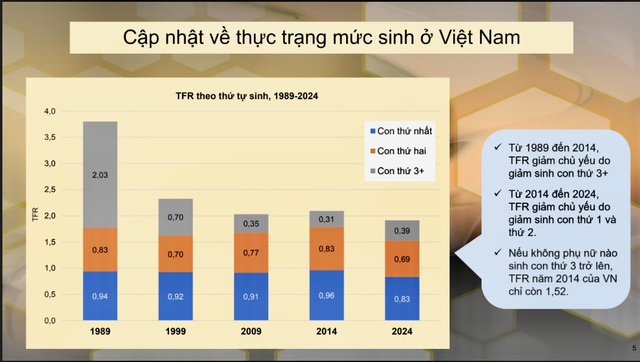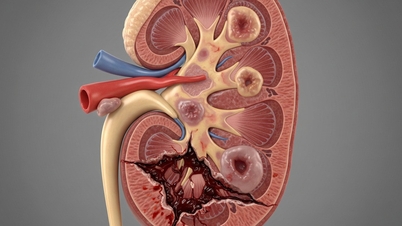Lowest birth rate in 63 years
The workshop "Fertility in Vietnam: Current situation and policy solutions" was organized by the Institute of Sociology and Psychology (under the Vietnam Academy of Social Sciences ) on the afternoon of September 23, with the participation of experts and managers.
At the workshop, Associate Professor Dr. Nguyen Duc Minh, Vice President of the Vietnam Academy of Social Sciences, said that in the 1970s, Vietnamese women gave birth to an average of 5 children. After many efforts to implement the birth reduction policy, Vietnam entered the replacement fertility stage (2.01 children/woman) in 2006; and successfully maintained the replacement fertility level of 2.01 children/woman until 2022.
By 2023, the fertility rate will drop to only 1.96 children per woman, the lowest in 63 years (since 1960 when the population policy was implemented), marking a sharp decline in fertility and making Vietnam the country with the lowest fertility rate in Southeast Asia.

Falling birth rates as more women delay having children
PHOTO: CONFERENCE DOCUMENTS
Associate Professor Minh noted that in many provinces and cities, especially urban areas and provinces with high levels of development, the birth rate has fallen below the replacement level. However, in some disadvantaged areas, mountainous areas, and ethnic minority areas, the birth rate remains high, creating a significant difference between regions.
For example, in the Southeast region, the birth rate has dropped below 1.5 children per woman, while many northern mountainous provinces have a birth rate above 2.5 children per woman.
Associate Professor Minh pointed out that the rapid aging of the population, the imbalance in gender at birth, and the low quality of the population pose an urgent need to adjust population policy in a comprehensive and sustainable direction.
Birth rate decline accelerates population aging
Providing more information about the current situation of declining birth rates, Associate Professor Dr. Nguyen Duc Vinh, former Director of the Institute of Sociology, said that the birth rate in the country is decreasing sharply and there is a large difference between regions. If in 2014 there were 16 provinces and cities with a total fertility rate (TFR) of over 2.5 children/woman, by 2024 there will be only 6 provinces.
"Statistics show that from 1989 to 2014, Vietnam's birth rate decreased mainly due to restrictions on having three or more children. But in the period 2014 to 2024, the birth rate continued to decrease mainly due to an increasing number of women postponing or delaying having their first and second children," Mr. Vinh stated the reason.
According to research in 2024 in 4 provinces with low birth rates (Khanh Hoa, Ho Chi Minh City, Soc Trang , Ca Mau), the average number of children desired by men is 2.2 and by women is 2.1. Particularly in Soc Trang and Ca Mau, women want to have less than 2 children.
On average, the total number of children planned is from 1.96 to 2.1, lower than the desired number.
At the workshop, some opinions expressed concern that the trend of low birth rate will lead to a decline in population size in the future, a decline in human resources, accelerating the aging process of the population, putting pressure on social security and economic development.
Therefore, studying the current fertility rate to propose appropriate policy solutions is an urgent issue of strategic significance for the development of the national population and human resources in particular, and the sustainable development of the country in general in the new context.
It is necessary to focus on strengthening support policies, encouraging childbirth and family care. In addition, housing, nursery, school, health and reproductive support policies also need to be taken into account to maintain reasonable birth rates.
At the same time, policy recommendations need to clarify whether birth promotion should be nationwide or only in low-fertility areas.
Source: https://thanhnien.vn/ngay-cang-nhieu-phu-nu-tri-hoan-sinh-con-quy-mo-dan-so-suy-giam-trong-tuong-lai-185250923171754006.htm


![[Photo] Prime Minister Pham Minh Chinh chairs the Government's online conference with localities](https://vphoto.vietnam.vn/thumb/1200x675/vietnam/resource/IMAGE/2025/10/5/264793cfb4404c63a701d235ff43e1bd)

![[Photo] Prime Minister Pham Minh Chinh launched a peak emulation campaign to achieve achievements in celebration of the 14th National Party Congress](https://vphoto.vietnam.vn/thumb/1200x675/vietnam/resource/IMAGE/2025/10/5/8869ec5cdbc740f58fbf2ae73f065076)











![[Photo] Students of Binh Minh Primary School enjoy the full moon festival, receiving the joys of childhood](https://vphoto.vietnam.vn/thumb/402x226/vietnam/resource/IMAGE/2025/10/3/8cf8abef22fe4471be400a818912cb85)











































![[VIDEO] Summary of Petrovietnam's 50th Anniversary Ceremony](https://vphoto.vietnam.vn/thumb/402x226/vietnam/resource/IMAGE/2025/10/4/abe133bdb8114793a16d4fe3e5bd0f12)

![[VIDEO] GENERAL SECRETARY TO LAM AWARDS PETROVIETNAM 8 GOLDEN WORDS: "PIONEER - EXCELLENT - SUSTAINABLE - GLOBAL"](https://vphoto.vietnam.vn/thumb/402x226/vietnam/resource/IMAGE/2025/7/23/c2fdb48863e846cfa9fb8e6ea9cf44e7)


































Comment (0)